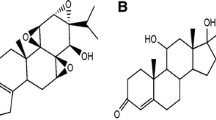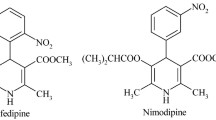Abstract
Purpose. 1. To compare the disposition of tracer morphine ([3H]M)following systemic and intraduodenal administration in therecirculating, rat small intestine preparation in absence or presence of verapamil(V), an inhibitor of P-glycoprotein. 2. To develop a physiological modelto explain the observations.
Methods. A bolus dose of [3H]M was added to the reservoir or injectedinto the duodenum of the rat small intestine preparation. V (200 μMin reservoir) was either absent (control studies) or present. Intestinalmicrosomal, incubation studies were performed to evaluate the effectof V on morphine glucuronidation.
Results. After systemic administration, [3H]M was not metabolizedbut was exsorbed into lumen. By contrast, both [3H]M and the3β-glucuronide metabolite, [3H]M3G, appeared in reservoir and lumenafter intraduodenal administration. A physiologically-based model thatencompassed absorption, metabolism and secretion was able to describethe route-dependent glucuronidation of M. The presence of V resultedin diminished levels of M3G in perfusate and lumen and mirrored theobservation of decreased glucuronidation in microsomal incubations.Verapamil appeared to be an inhibitor of glucuronidation and notsecretion of M.
Conclusions. M was secreted and absorbed by the rat small intestine.Route-dependent glucuronidation of M was explained by physiologicalmodeling when M was poorly partitioned in intestinal tissue, with alow influx clearance from blood and a even poorer efflux clearancefrom tissue. The poor efflux rendered a much greater metabolism ofM that was initially absorbed from the lumen. V increased the extentof M absorption through inhibition of M glucuronidation.
Similar content being viewed by others
REFERENCES
A. Tsuji and I. Tamai. Carrier-mediated intestinal transport of drugs. Pharm. Res. 13:963-977 (1996).
K. F. Ilett, L. B. Tee, P. T. Reeves, and R. F. Minchin. Metabolism of drugs and other xenobiotics in the gut lumen and wall. Pharmacol. Ther. 46:67-93 (1990).
R. K. Dubey and J. Singh. Localization and characterization of drug-metabolizing enzymes along the villus-crypt surface of the rat small intestine I. Monooxyenases Biochem. Pharmacol. 37:169-176 (1988).
R. K. Dubey and J. Singh. Localization and characterization of drug-metabolizing enzymes along the villus-crypt surface of the rat small intestine II. Conjugases Biochem. Pharmacol. 37: 177-184 (1988).
P. B. Watkins, S. A. Wrighton, E. G. Schuetz, D. T. Molowa, and P. S. Guzelian. Identification of glucocorticoid-inducible cytochrome P-450 in the intestinal mucosa of rats and man. J. Clin. Invest. 80:1029-1036 (1987).
M. F. Paine, D. D. Shen, K. L. Kunze, J. D. Perkins, C. L. Marsh, J. P. McVicar, D. M. Barr, B. S. Gilles, and K. E. Thummel. First-pass metabolism of midazolam by the human intestine. Clin. Pharmacol. Ther. 60:14-24 (1996).
M. F. Paine, M. Khalighi, J. M. Fisher, D. D. Shen, K. L. Kunze, C. L. Marsh, J. D. Perkins, and K. E. Thummel. Characterization of interintestinal and intraintestinal variations in human CYP3A-dependent metabolism. J. Pharmacol. Exp. Ther. 283:1552-1562 (1997).
C.-Y. Wu, L. Z. Benet, M. F. Herbert, S. K. Gupta, M. Rowland, D. Y. Gomez, and V. J. Wacher. Differentiation of absorption and first-pass gut metabolism in humans: studies with cyclosporine. Clin. Pharmacol. Ther. 58:492-497 (1995).
A. Lampen, Y. Zhang, I. Hackbarth, L. Z. Benet, K.-Fr. Sewing, and U. Christians. Metabolism and transport of the macrolide sirolimus in the small intestine. J. Pharmacol. Exp. Ther. 285:1104-1112 (1998).
H. Saitoh and B. J. Aungst. Possible involvement of multiple P-glycoprotein mediated efflux systems in the transport of verapamil and other organic cations across rat intestine. Pharm. Res. 12:1304-1310 (1995).
K. S. Lown, R. R. Mayo, A. B. Leichtman, H.-L. Hsiao, K. Turgeon, P. Schmiedin-Ren, M. B. Brown, W. Guo, S. J. Rossi, L. Z. Benet, and P. B. Watkins. Role of intestinal P-glycoprotein (mdr1) in interpatient variation in the oral bioavailability of cyclosporine. Clin. Pharmacol. Ther. 62:48-60 (1997).
J. W. Smit, A. H. Schinkel, M. Müller, B. Weert, and D. K. F. Meijer. Contribution of the murine mdr1a P-glycoprotein to hepatobiliary and intestinal elimination of cationic drugs as measured in mice with an mdr1a gene disruption. Hepatology 27:1056-1063 (1998).
M. Doherty and K. S. Pang. The role of the intestine in the absorption and metabolism of drugs. Drug Chem. Toxicol. 20:329-344 (1997).
V. J. Wacher, J. A. Silverman, Y. Zhang, and L. Z. Benet. Role of P-glycoprotein and cytochrome P450 3A in limiting oral absorption of peptides and peptidomimetics. J. Pharm. Sci. 87:1322-1330 (1998).
S. D. Hall, K. E. Thummel, P. B. Watkins, K. S. Lown, L. Z. Benet, M. F. Paine, R. R. Mayo, D. K. Turgeon, D. G. Bailey, R. J. Fontana, and S. A. Wrighton. Symposium Article. Molecular and physical mechanisms of first-pass extraction. Drug Metab. Dispos. 27:161-166 (1999).
J. H. Lin, M. Chiba, and T. A. Baillie. Is the role of the small intestine in first-pass metabolism overemphasized? Pharmacol. Rev. 51:135-158 (1999).
K. S. Pang, W. F. Cherry, and E. H. Ulm. Disposition of enalapril in the perfused rat intestine-liver preparation: Absorption, metabolism and first pass effect. J. Pharmacol. Exp. Ther. 233:788-795 (1985).
K. S. Pang, S. Fayz, V. Yuen, J. te Koppele, and G. J. Mulder. Absorption and metabolism of acetaminophen by the in situ perfused rat small intestine preparation. Drug Metab. Dispos. 14:102-113 (1986).
M. M. Doherty, K. Poon, and K. S. Pang. Morphine disposition in the vascularly perfused in situ rat intestine preparation. Abstract, ASPET Meeting, San Diego, (1997).
Y. Wen, R. P. Remmel, and C. L. Zimmerman. First-pass disposition of (-)-6-aminocarbovir in rats. 1. Prodrug activation may be limited by access to enzyme. Drug Metab. Dispos. 27: 113-121 (1999).
K. S. Lown, J. C. Kolars, K. E. Thummel, J. L. Barnett, K. L. Kunze, S. A. Wrighton, and P. B. Watkins. Interpatient heterogeneity in expression of CYP3A4 and CYP3A5 in small bowel. Lack of prediction by the erythromycin breath test. Drug Metab. Dispos. 22:947-955 (1994).
P. B. Watkins, S. A. Murray, L. G. Winkelman D. M. Heuman, S. A. Wrighton, and P. S. Guzelian. Erythromycin breath test as an assay of glucuocorticoid-inducible liver cytochrome P-450. J. Clin. Invest. 83:688-697 (1989).
E. del Villar, E. Sanchez, and T. R. Tephly. Morphine metabolism II. Studies on morphine glucuronyltransferase activity in intestinal microsomes of rats. Drug. Metab. Dispos. 2:370-374 (1974).
A. S. Koster and J. Noordhoek. Glucuronidation in isolated per fused rat intestinal segments after mucosal and serosal administration of 1-naphthol. J. Pharmacol. Exp. Ther. 226:553-538 (1983).
R. Callaghan and J. R. Riordan. Synthetic and natural opiates interact with P-glycoprotein in multidrug resistant cells. J. Biol. Chem. 268:16059-16064 (1993).
A. H. Schinkel, E. Wagenaar, L. Van Deemter, C. A. A. M. Mol, and P. Borst. Absence of the mdr1a P-glycoprotein in mice affects tissue distribution and pharmacokinetics of dexamethasone, digoxin, and cyclosporin A. J. Clin. Invest. 96:1968-1705 (1995).
T. Tsuruo, H. Tida, S. Sukagashi, and Y. Sakurai. Overcoming the vincristine resistance in P833 leukemia in vivo and in vitro through enhanced cytotoxicity of vincristine and vinblastine by verapamil. Cancer Res. 41:1967-1972 (1991).
O. H. Lowry, N. J. Rosebrough, A. L. Farr, and R. J. Randall. Protein measurements with the folin phenol reagent. J. Biol. Chem. 193:265-275 (1951).
O. Svensson, A. Rane, J. Sawe, and F. Sjoqvist. Determination of morphine, morphine-3-glucuronide and (tentatively) morphine-6-glucuronide in plasma and urine using ion-pair high-performance liquid chromatography. J. Chromatogr. 230:427-432 (1982).
L. I. Harrison, and M. Gibaldi. Physiologically based pharmacokinetic model for digoxin distribution and elimination in the rat. J. Pharm. Sci. 66:1138-1142 (1977).
E. M. Kenyon and E. J. Calabrese. Extent and implications of interspecies differences in the intestinal hydrolysis of certain glucuronide conjugates. Xenobiotica 23:373-381 (1993).
H. Hirayama, X. Xu, and K. S. Pang. Viability of the vascularly perfused, recalculating rat intestine and intestine-liver preparations. Am. J. Physiol. 89:G249-G258 (1989).
M. Mistry and J. B. Houston. Glucuronidation in vitro and in vivo. Comparison of intestinal and hepatic conjugation of morphine, naloxone, and buprenorphine. Drug. Metab. Dispos. 15:710-717 (1987).
A. S. Koster, A. C. Frankhuijzen-Sierevogel, and J. Noordhoek. Glucuronidation of morphine and six β2-sympathominetics in isolated rat intestinal epithelial cells. Drug. Metab. Dispos. 13:232-237 (1985).
D. Cong, M. Doherty, and K. S. Pang. A new, physiologically-based segregated-flow model to explain route-dependent intestinal metabolism. Drug Metab. Dispos. 28:224-235 (2000).
C. T. Walsh and R. E. Levine. Studies of the enterohepatic circulation of morphine in the rat. J. Pharmacol. Exp. Ther. 195:303-310 (1975).
S. F. Brunk and M. Delle. Morphine metabolism in man. Clin. Pharmacol. Ther. 16:51-57 (1974).
S. P. Letrent, J. W. Polli, J. E. Humphreys, G. M. Pollack, K. R. Brouwer, and K.L.R. Brouwer. P-glycoprotein-mediated transport of morphine in brain capillary endothelial cells. Biochem. Pharmacol. 58:951-957 (1999).
S. P. Letrent, G. M. Pollack, K. R. Brouwer, and K. L. R. Brouwer. Effect of GF 120918, a potent P-glycoprotein inhibitor, on morphine pharmacokinetics and pharmacodynamics in the rat. Pharm. Res. 15:599-605 (1998).
J. F. Rajaonarison, B. Lacrelle, J. Catalin, M. Placidi, and R. Rahmani. 3′-Azido-3′-deoxythymidine drug interactions. Drug. Metab. Dispos. 20:578-584 (1992).
Author information
Authors and Affiliations
Additional information
This work was supported by the Medical Research Council of Canada (MA9104 and MOP-36457) and was presented in part at the ASPET meeting in San Diego, 1997 and the AAPS meeting in Boston, 1997.
Rights and permissions
About this article
Cite this article
Doherty, M.M., Pang, K.S. Route-Dependent Metabolism of Morphine in the Vascularly Perfused Rat Small Intestine Preparation. Pharm Res 17, 291–298 (2000). https://doi.org/10.1023/A:1007548905772
Issue Date:
DOI: https://doi.org/10.1023/A:1007548905772




